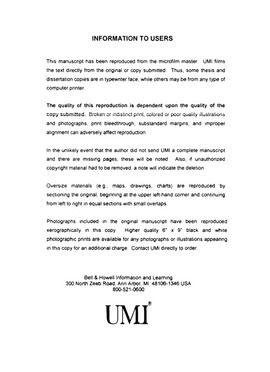| dc.contributor.advisor | Schubert, Karel, | en_US |
| dc.contributor.author | Gavilano, Lily Beatriz. | en_US |
| dc.date.accessioned | 2013-08-16T12:31:07Z | |
| dc.date.available | 2013-08-16T12:31:07Z | |
| dc.date.issued | 2000 | en_US |
| dc.identifier.uri | https://hdl.handle.net/11244/6017 | |
| dc.description.abstract | Both, sesquiterpene lactones isolated from Ambrosia and trypsin inhibitors isolated from Cassia and from Mucuna are new potential tools to engineer transgenic plants with resistance to plant parasitic nematodes. | en_US |
| dc.description.abstract | Bioactive defense-related proteins include proteins such as protease inhibitors. Trypsin inhibitors have exhibited antiinsect, antifungal and nematicidal activities. The gene for trypsin inhibitor may protect plants from different pests and pathogens when expressed in transgenic plants. For this reason, we are involved in the isolation of novel trypsin inhibitors. Earlier studies indicated that seeds of Cassia fruticosa and Mucuna holdii, two tropical species, possess trypsin inhibitory activity. Trypsin inhibitors were isolated from both species by affinity chromatography. Isoforms of trypsin inhibitors were further purified by anion exchange chromatography. | en_US |
| dc.description.abstract | Three trypsin inhibitors were purified from Cassia. Five trypsin inhibitors were detected in Mucuna seed extract and these inhibitors exhibited high thermostability. Based on SDS-PAGE, the molecular weight of the purified trypsin inhibitors from Cassia was 17,700 Da and inhibitors from Mucuna were found to possess a molecular weight around 9,000 Da. Their molecular weight was also determined by MALDI-TOF laser mass spectrometry. MALDI-TOF mass analysis indicated that the molecular weights of Cassia and Mucuna inhibitors were 21,500 and 8,000 Da, respectively. Bioassays of trypsin inhibitors using a Caenorhabditis elegans feeding bioassay indicated that the trypsin inhibitors from both Cassia and Mucuna were capable of causing nematode mortality under the conditions of the bioassay. | en_US |
| dc.description.abstract | The purpose of this research was to discover novel biological substances with nematicidal activity. Plants contain a variety of bioactive natural products. Many of them may play a role in plant defense. Plants also contain bioactive proteins involved in defense. Two groups of plants were tested for nematicidal activity. The nematicidal activity found in the first group of plants was attributed to the presence of secondary metabolites, while the activity found in the second group was apparently due to the presence of active proteins. Aqueous extracts of Solidago missouriensis, Ambrosia psilostachya and Lespedeza stuevei, native plants of the United States, were tested for activity against M. incognita juveniles. Solidago and Ambrosia reduced gall formation in tomato infected with M. incognita in greenhouse experiments. In laboratory experiments, extracts of Solidago exerted a nernatistatic effect. Lespedeza inhibited nematode motility temporarily. Of the three, only A. psilostachya crude extract exhibited nematicidal activity, causing 100% mortality at a concentration of 20 mg/ml. Bioactivity-directed TLC fractionation of Ambrosia extract resulted in the isolation of three nematicidal secondary metabolites. The structures of two of these compounds, parthenin and coronopilin, were determined by NMR and mass spectrometry. Parthenin and coronopilin, are known sesquiterpenes and these compounds were reported previously to possess antitumor, antibacterial, antifungal, molluscicidal and insect antifeedant activities. However, this is the first report of their nematicidal activity. We proposed a model for the mode-of-action of parthenin in which the parthenin reacts with essential sulfhydryl groups of proteins. To test this hypothesis, parthenin was mixed with cysteine and then tested for nematicidal activity. Indeed, the nematicidal effect of parthenin was reduced 95% by mixing the compound with equimolar concentrations of cysteine. This suggests that the lethal effect of parthenin on nematodes is due to reaction with sulfhydryl groups present in essential proteins. | en_US |
| dc.format.extent | xvi, 202 leaves : | en_US |
| dc.subject | Trypsin inhibitors. | en_US |
| dc.subject | Nematocides. | en_US |
| dc.subject | Metabolites. | en_US |
| dc.subject | Biomolecules. | en_US |
| dc.subject | Biology, Molecular. | en_US |
| dc.subject | Biology, Plant Physiology. | en_US |
| dc.subject | Proteins. | en_US |
| dc.title | Discovery, isolation and characterization of novel biomolecules with nematicidal activity. | en_US |
| dc.type | Thesis | en_US |
| dc.thesis.degree | Ph.D. | en_US |
| dc.thesis.degreeDiscipline | Department of Microbiology and Plant Biology | en_US |
| dc.note | Adviser: Karel Schubert. | en_US |
| dc.note | Source: Dissertation Abstracts International, Volume: 61-07, Section: B, page: 3419. | en_US |
| ou.identifier | (UMI)AAI9980453 | en_US |
| ou.group | College of Arts and Sciences::Department of Microbiology and Plant Biology | |
